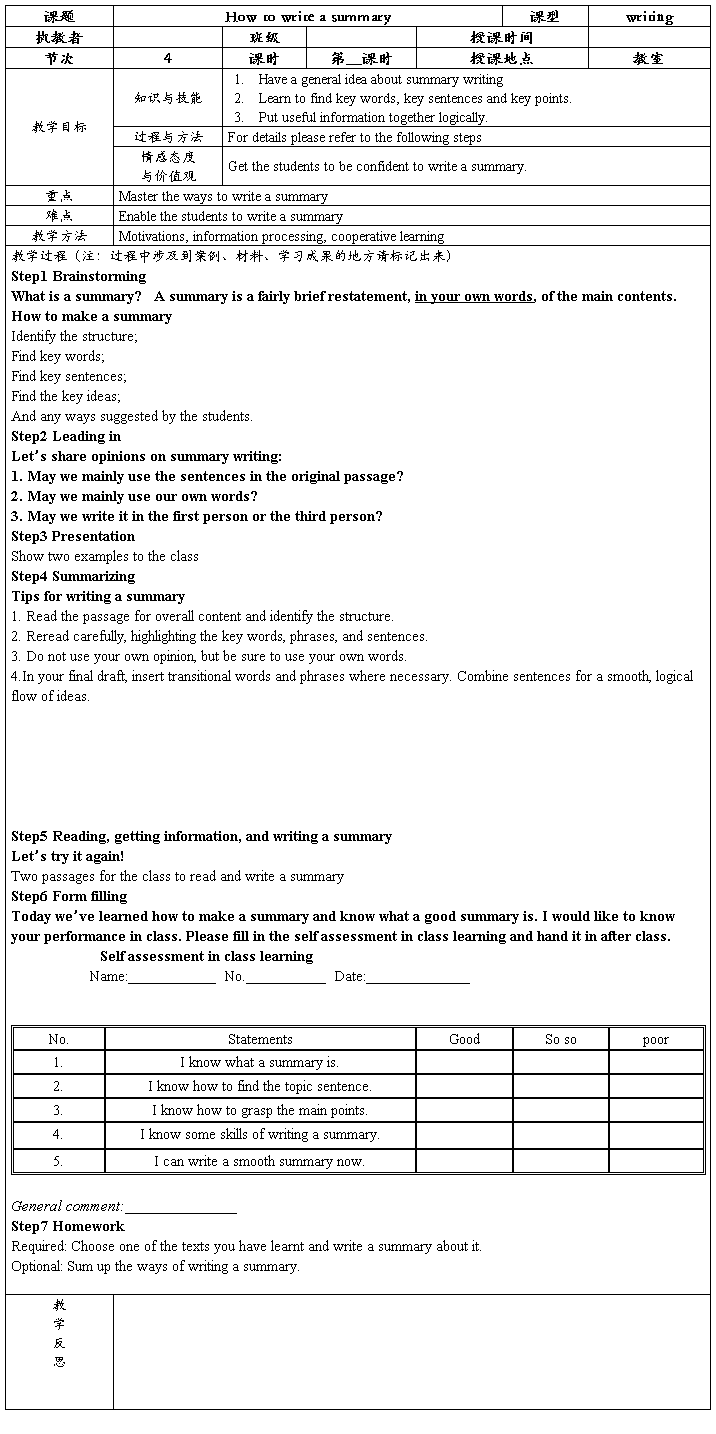How to write a summary
How to Write a Summary
What is a Summary?
A summary is a brief restatement--in your own words--of the content of a piece of writing.
A summary - or précis - is a shorter version of a longer piece of writing. The summary captures all the most important parts of the original, but expresses them in a [much] shorter space.
When you write a summary, remember your purpose. You are demonstrating that you fully understand a passage that you have read. A good summary is brief, complete, and objective. Find the author's main idea and subordinating ideas and show your clear understanding of the structure.
A summary is a short version of the text with only its most important pieces of information. It provides the reader with a clear idea of what the original text – no matter whether it is fictional or non-fictional – is all about.
In a fictional text a summary deals with the development of the action.
In a non-fictional text a summary outlines the main line of argument.
Why Write a Summary?
To help you understand the text and see its strengths and weaknesses.
To teach you how to take notes while doing research papers.
To help you find key points/ideas so that you can more easily answer essay questions on tests.
To help you condense and present long stretches of information from a textbook or lecture.
How to Write a Summary?
?1. the passage carefully. Determine its structure. Identify the author's purpose in writing. (This will help you to distinguish between more important and less important information.) Skim the text, noting in your mind the subheadings. If there are no subheadings, try to divide the text into sections. Consider why you have been assigned the text. Try to determine what type of text you are dealing with. This can help you identify important information.
?2. . This time divide the passage into sections, either single paragraphs or groups of paragraphs that focus on the same topic. Label, on the passage itself, each section’s main point. Underline key ideas and terms.
?3. These summaries should state the main idea of each section. Eliminate specific examples, facts, illustrations, and other supporting evidence. The summary should be expressed - as far as possible - in your own words. It's not enough to merely copy out parts of the original.
?4. . The thesis should express the central idea of the passage, as you have determined it from the preceding steps. You may find it useful to keep in mind the information contained in the lead sentence or paragraph of most newspaper stories--the what, who, why, where, when, and how of the matter. For persuasive passages, summarize in a sentence the author's conclusion. For descriptive passages, indicate the subject of the description and its key features.
?Note: In some cases a suitable thesis may already be in the original passage. If so, you may want to quote it directly in your summary.
?5. by starting with your thesis and combining it with your list of sentence summaries. At this stage, you should include any significant details from the passage. Be sure to eliminate repetition and eliminate less important information. Disregard minor details, or generalize them. Use as few words as possible to convey the main ideas. Write a one or two-sentence account of each section you identify. Focus your attention on the main point. Leave out any illustrative examples.
?6. , and make whatever adjustments main idea of the entire text in your own words.
?7. , inserting words and phrases where necessary to ensure coherence. Check for style. Avoid series of short, choppy sentences. Combine sentences for a smooth, logical flow of ideas. Check for grammatical correctness, punctuation, and spelling.
Requirements:
? ?Be concise and brief.
?The summary should cover the original as a whole.
?The material should be presented in a neutral fashion.
?The summary should be significantly shorter than the original (a good length for an article of 1000 words might be 200- 250 words).
? ?Follow the order of the original text.
?Do not include statistics, dates, examples, quotations, stylistic means, any details from the text, or your own opinion or interpretation. Also do not include anything that does not appear in the original. (Do not include your own comments or evaluation.)
?that you do not plagiarize (do not follow the author's sentence structure and do not claim his/her ideas or language as your own).
?.
?Refer to authors in subsequent sentences by their last names only.
?Remember that it must be in your own words. By writing in this way, you help to re-create the meaning of the original in a way which makes sense for you. ?Before you even start, make a note of your source(s). If this is a book, an article, or a journal, write the following information at the head of your notes: Author, title, publisher, publication date, and edition of book.
第二篇:How to write a summary 英语作文 教案模板
 珠海市第x中学教案
珠海市第x中学教案

-
150篇Argumentative Essay Topics
150BestArgumentativeEssayTopicsPostedonJanuary24th20xxLookingforeffectivean…
-
How to write an argumentative essay
Howtowriteanargumentativeessay如何写英语议论文不同观点列举型选择型Thereisawidesprea…
-
argumentative essay
ArgumentativeEssaysSummaryTheModesofDiscourseExpositionDescriptionNarration…
-
argumentative essay
HUDSONCOLLEGEArgumentativeEssay400academicskillsTeacherMariaAimimirJunxiang…
-
Argumentative Essay Sample
ArgumentativeEssaySampleEconomicGrowthandEnvironmentalDamageThoughnowadaysi…
-
The probation period work summary report
TheprobationperiodworksummaryreportRespectleadershipHelloInaninstanttocompa…
-
英文summary写作范例
ArticleChildrenMustbeTaughttoTellRightfromWrongWilliamKilpatrickManyoftoday…
-
怎么写英文摘要summary
摘要是对一篇文章的主题思想的简单陈述它用最简洁的语言概括了原文的主题写摘要主要包括三个步骤1阅读2写作3修改成文第一步阅读A认真阅…
-
summary 范文
OriginalMyneighbor39schildrenloveplayinghideandseekasallchildrendobutnoonei…
-
英文读写summary范文
ThesummaryofNiceGuysAndGirlsFinishTogetherInNicholasDKristofsNiceGuysAndGir…